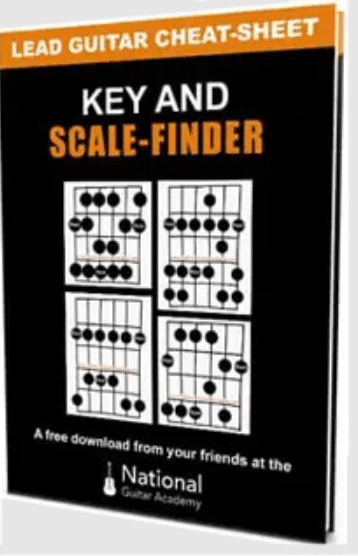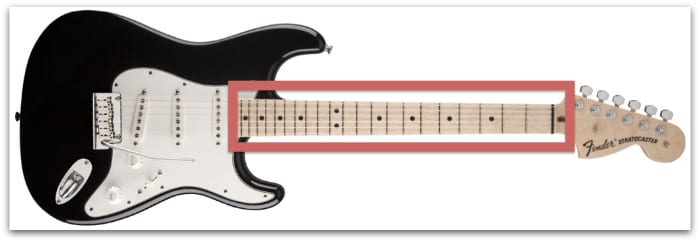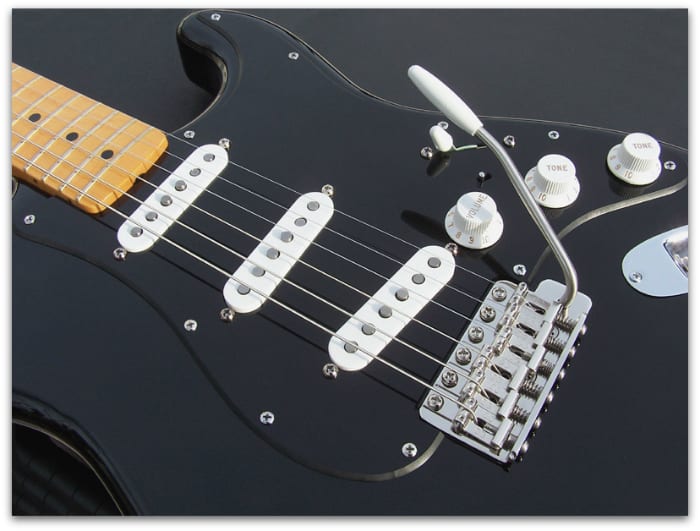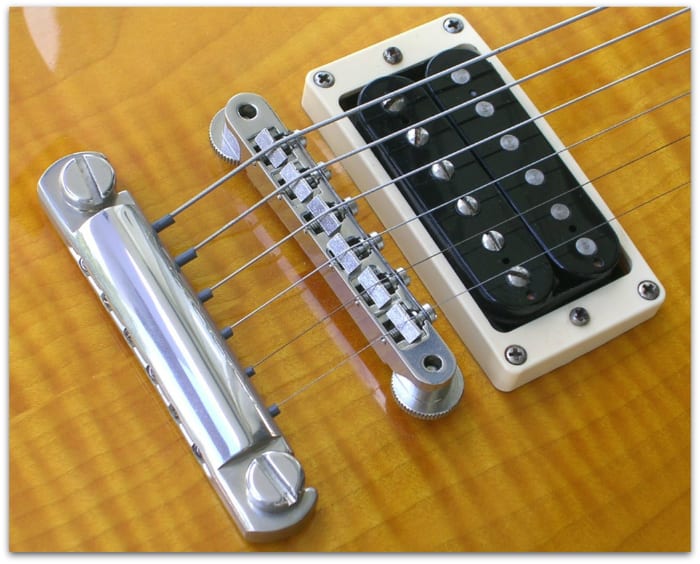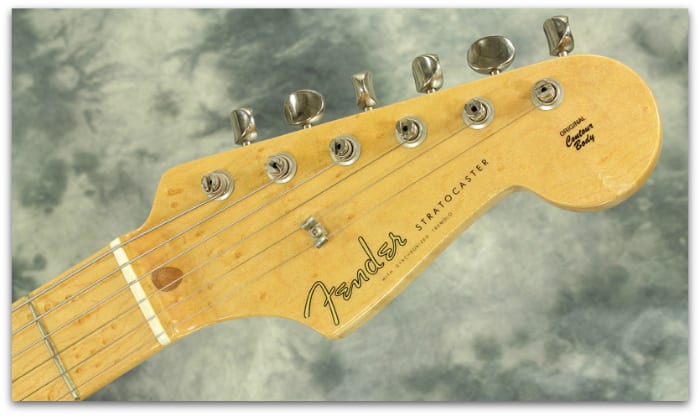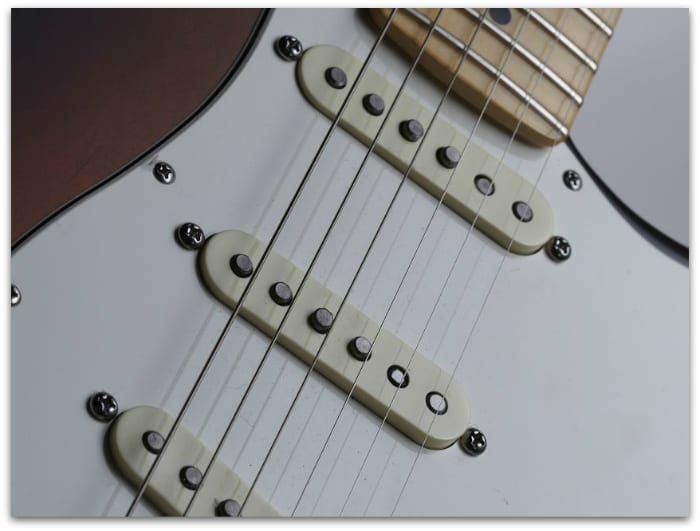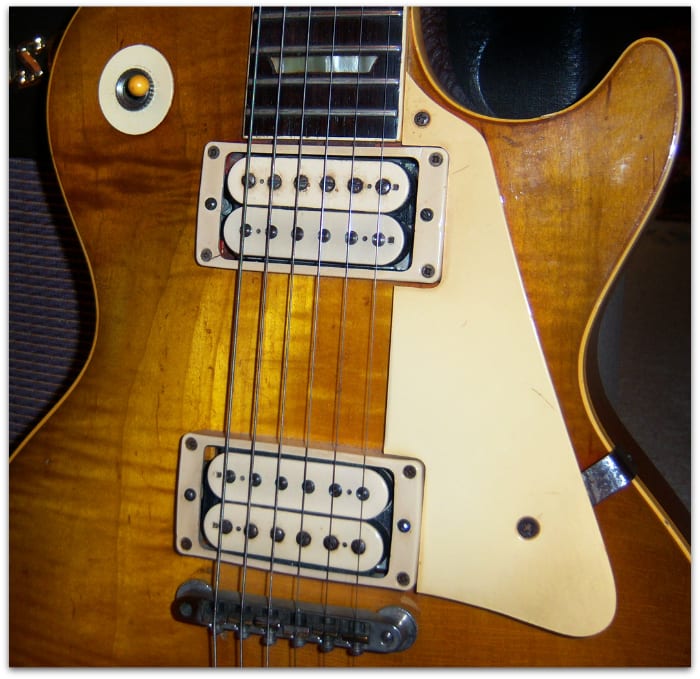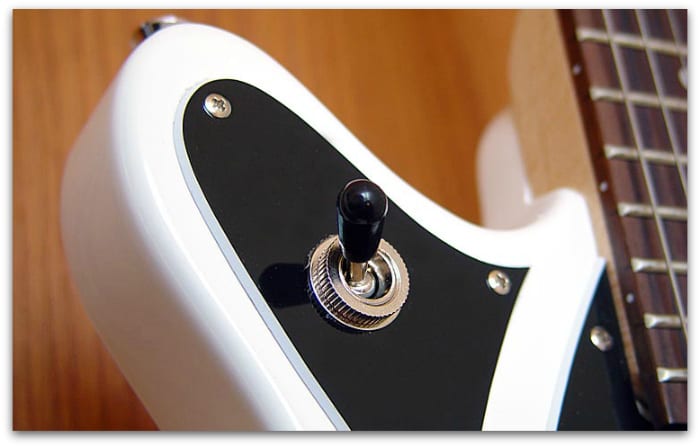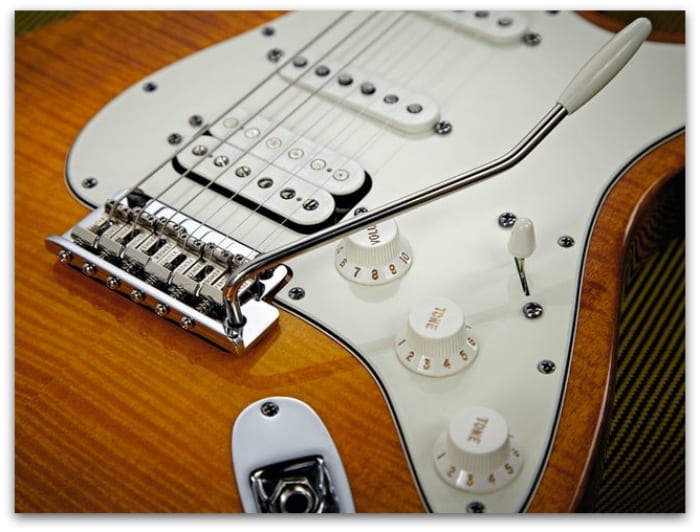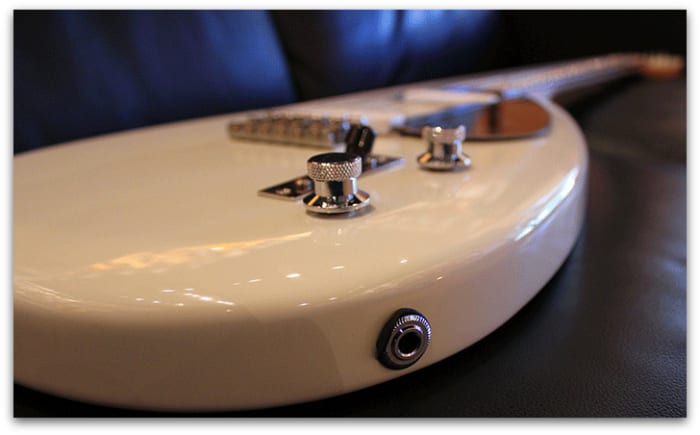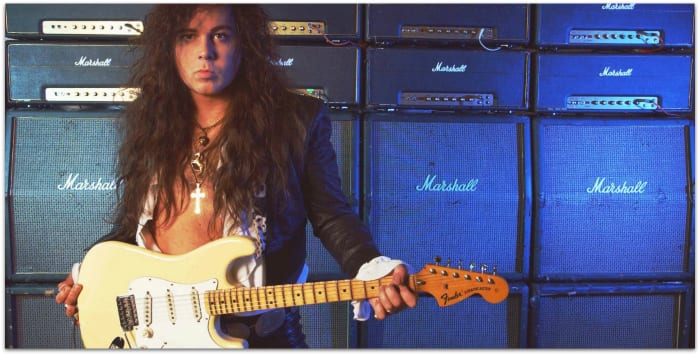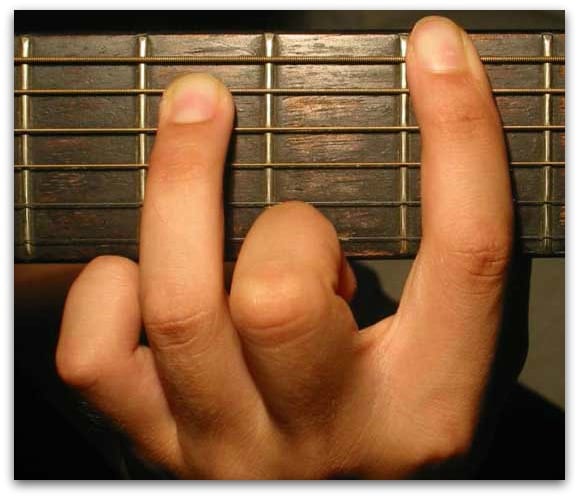Wondering how to play electric guitar? This guide will get you up to speed quickly.
In this free guitar lesson you will learn:
- Electric guitar anatomy & what the different parts do
- How to make your amp sound good (from crystal clean to super high-gain rock sounds)
- How to adapt chords for electric guitar
- How to play powerchords and sound huge
- Two killer electric guitar riffs
- 3 awesome techniques which are vital for learning electric guitar
The Anatomy of an Electric Guitar
There are hundreds of different models of electric guitar and it would take years to explain each one.
However, there are common components.
The Fretboard
This is where we play chords or ‘fret’ (press down) notes.
The Bridge
This is what holds our strings in place and is usually placed on the bottom of the guitar.
On an electric guitar you can get a variety of different bridges such as:
The ‘Floating Bridge’
The ‘Floating Bridge’ usually has a ‘tremolo arm’ which is used to change the pitch of your guitar.
If you press it down the pitch of your note gets lower, if you raise it the pitch gets higher.
The ‘Fixed Bridge’
These are really useful for keeping your guitar solidly in tune as they don’t change the pitch of your guitar.
The ‘Machine heads’
These are used to change the pitch of each string.
The ‘Pickups’
These are what ‘amplify’ your guitar and allow it to be heard through an amp.
You can get a variety of different pickups, but the main ones are either ‘Single coils’ or ‘Humbuckers’.
‘Single Coils’
These create a thinner sound but are great for blues, funk or pop! They are often seen in Fender Stratocasters or Telecasters.
‘Humbuckers’
These sound a lot thicker than a single coil, so are great for heavier styles of music such as Rock, Metal or even blues. They are often seen in Gibson Les Paul’s or Ibanez guitars.
The ‘Pickup Selector’ Switch
This is how we to select each pickup on our guitar. This can be incredibly useful as it provides a wide variety of sounds!
On most guitars we have a ‘neck’ pickup and a ‘bridge’ pickup.
The ‘neck’ pickup is the one closest to the Neck and has a softer, warmer sound.
The ‘Bridge’ pickup is the one closest to the bridge and has a brighter, aggressive sound.
Learn 12 EASY beginner chords with our popular guide
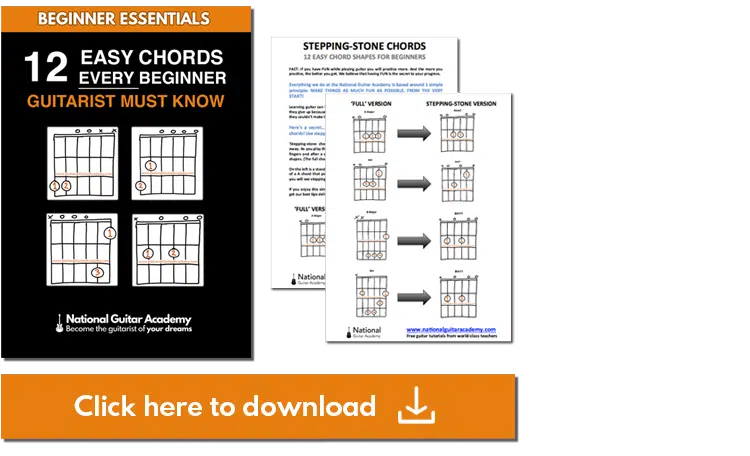
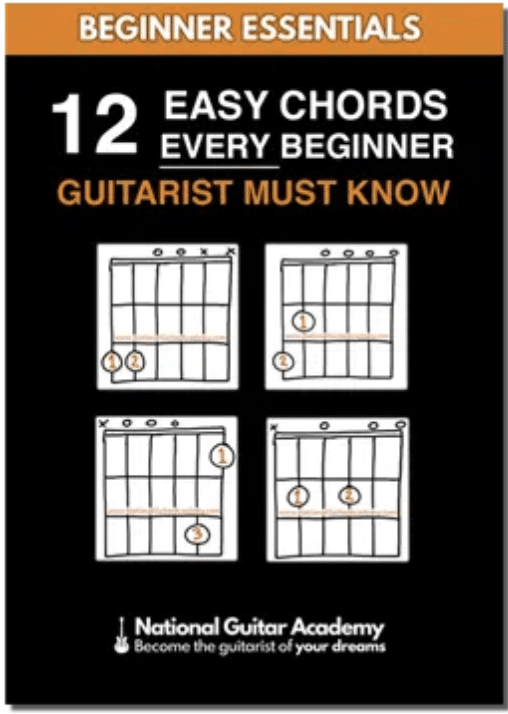
Where should we send it?
✅ Stop struggling. Start making music.
✅ Learn beginner-friendly versions of every chord.
This is our most popular guide and it will improve your chord ability quickly! 😎
Get your own personalised guitar-learning plan 🎸
Get a custom guitar-learning plan here: Click here for GuitarMetrics™
World-Class Guitar Courses 🌎
Learn from the world's best guitar educators: Click here for our guitar courses
The ‘Volume’ and ‘Tone’ Controls
Volume is what controls the overall level of your electric guitar.
Tone controls determine whether your guitar has a bright or dark sound.
If it is rolled all the way off the sound is darker, if its on full the sound is brighter.
The ‘Input Jack’
This is where you plug your guitar lead into which then goes into an amp.
How to set up your guitar amp
Before we get started on learning some great guitar riffs, we need to have a great amp sound.
Without this, it can be impossible to sound good!
If the amp sound is bad, this can often un-inspire us and lead us to think we’re playing badly when we’re actually not.
However, if we have a great amp sound, this does inspire us and lets us rock out to our heart’s content.
When setting up our amp, we often use specific sounds for certain songs.
- So if we’re playing a Beatles sound, we would want a clean sparkly sound.
- Where as if we were rocking out to some AC/DC we might want something a little bit heavier.
Dialling in the right sound when playing electric guitar is vital to sounding good.
This can often be daunting as there are so many different knobs and buttons and amps it can be hard to know where to start.
So lets start simple and break down each one.
Amp Controls
Every amp is different, and some have hundreds of different buttons which do crazy things.
However 90% of guitar amps will have these controls.
The ‘Gain’ knob
- This controls how much overall distortion you want. The more the knob is turned down the less you have, more its turned up the more distortion you have.
The ‘Bass’ knob
- This controls how ‘bassy’ you want your amp to be. This can come in really handy for when you want to sound huge! But use it sparingly. The ‘Bass’ control adds a lovely thud to your guitar sound.
The ‘Middle’ knob
- This controls the ‘mids’ of your guitar. This adds thickness to your sound and really helps you cut through in a band! You may find the more you turn it up the ‘honkier’ your guitar sound gets.
The ‘Treble’ knob
- This controls how bright you want your guitar to sound. This is really good for clean sounds, as it adds ‘sparkle’ to your guitar.
The ‘Presence’ knob
- A lesser known tone control, however really important as it adds more brightness to your sound. It’s like the treble control, but more. Really great for those funky crisp guitar lines.
The ‘Master/Volume’ knob
- This controls the overall level or output of your guitar. Make sure this one is turned up nice and loud. 🙂
Dialling in the perfect tone
Now we understand what our amp does, let’s look at getting a great guitar sound.
We’re going to look at two guitar sounds.
- A super high gain sound, perfect for metal or rock.
- A jangly clean sound, great for pop or indie.
Want free guitar tips and video lessons delivered to your inbox?
Join over 100,000 guitar learners and subscribe to our guitar-tips-by-email service. (It's free.)
We'll send you a series of lessons that will move you to the next level of your guitar journey.
Learn how everything fits together quickly, easily and effectively. We share ninja tips (for instant fun!) but also timeless fundamentals that will deepen your understanding.


Get our best guitar tips & videos
Our Guitar Courses
To become a better guitarist click here to see our guitar courses
Get your personalised guitar-learning plan 🎸
Want us to make a guitar-learning plan that is customised to you? Click here for GuitarMetrics™
The ‘Super High Gain’ Sound
Sometimes your amp may have a separate channel for your distortion, make sure you check you are on the right channel before you dial in your sound.
You would use this sound in a rock song or a metal song.
Notice how the gain isn’t all the way up, it’s only just over half way. This is super important, as if we have too much distortion our guitar sound can get lost and will often sound messy.
I’ve also used a bit of bass to give our guitar sound some low end and some middle and treble to make it nice and clear!
You can adjust volume to taste.
Here’s what it sounds like.
The ‘Crystal Clean’ Guitar Sound
Playing with tons of distortion is one of the most fun things you can do on the guitar, but sometimes it’s nice to chill out and play some clean guitar.
This sounds great playing Beatles songs or modern indie.
Here’s how you would dial in your amp to get this classic tone.
Notice how the gain is relatively low, we want minimal to no distortion.
As well, I’ve used less Bass and mids. But more treble and presence to get a nice sparkle.
Some amps also have reverb, this works great as it adds some ambience to our already awesome guitar sound. (I added a touch here to enhance my clean sound.)
Adapting Chords for Electric Guitar
Even though the Electric guitar is very similar to an Acoustic Guitar. A number of chords sound better on Electric than Acoustic and vice versa.
One key chord type which is essential for Electric Guitar is the power chord.
This is a chord which isn’t used very often on Acoustics, however we hear this all the time on Electric Guitars.
The ‘Power Chord’
This is a chord which only uses two notes and sounds absolutely huge on an Electric Guitar.
There’s nothing more satisfying than hitting a huge power chord through a loud distorted amp!
The main reason for playing power chords on Electric Guitar rather than open chords, is they have a beefier sound.
Let’s take a look at a few power chords and compare them with our open chords.

